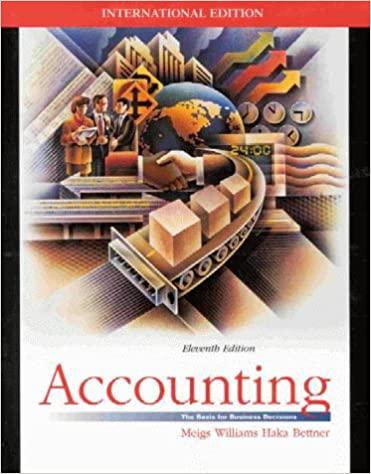Answered step by step
Verified Expert Solution
Question
1 Approved Answer
Calculation Problem 1 : Assume that a non - profit organization Louisiana Natural History Center ( LNHS ) started its fiscal year with the following
Calculation Problem :
Assume that a nonprofit organization Louisiana Natural History Center LNHS started its fiscal year with
the following balances shown in alphabetical order:
Item $ Amount
Accounts Payable $
Accounts Receivable $
Buildings and Equipment, NET $
Cash $
Inventory $
Notes Payable $
Permanently Restricted Net Assets $
Pledges Receivable $
Temporarily Restricted Net Assets $
Unrestricted Net Assets $
Wages Payable $
LNHC had the following highly summarized financial events during the current year:
Jan. Ordered new equipment with a useful life of years, for $ No payment was made
and no equipment has been delivered.
Jan. Received $ from a donor. The donor had pledged the money the prior year and
the donation was treated as revenue in that year.
Jan. Purchased $ of books and posters that will be sold in its store. A payment of
$ was made on that date, and the balance is owed to the supplier. LNHC expects to sell the
inventory for $
Feb. Paid $ deposit for the equipment ordered on Jan.
MBA Spring February
Page of
Mar. Received the equipment ordered on Jan. and paid the balance owed to the supplier in
full.
Apr. Paid $ of its debt on bills sent by its creditors.
Jun. Purchased a bus that will be used for LNHC operational activity. Full payment of $
was made at the time of purchase.
Dec. Tour and admission fees for the year were $ They were all collected.
Dec. LNHC paid its employees $ of wages. Wage expense for the year is $ The
payment included $ wages payable balance outstanding from the previous year plus some
payment for the work done this year.
Dec. Negotiated the purchase of a second bus for its operational activities for $ They
have not paid nor received the bus, but expect it to be delivered within next business days.
Dec. Book and poster sales for the year totaled $ All but $ of that amount has
been collected. of the balance of accounts receivable from the beginning of the year was
also collected. The cost of goods sold was $
Dec. LNHCs accumulated bus depreciation is $
Dec. LNHC makes a payment on its long term mortgage notes payable of $ The
note includes interest expense of $
Dec. LNHC buildings are now one year older. Depreciation for the year is $
Dec. LNHC estimates that $ of the receivables for book and poster sales made this year
will never be collected.
Questions:
Create the beginning balance sheet for LNHC
Record all above mentioned transactions in a worksheet similar to Exhibit on page rd
edition of the book
Prepare the ending balance sheet for LNHC
Create a comparative statement of Financial Position LNHC Exhibit
Create a statement of Cash Flows for the fiscal year under analysis.
Create an activity statement operating statement for the fiscal year under analysis.
What do you learn from these statements about LNHC position for that year? What questions
do these statements raise?
Calculation Problem pts:
A medical lab uses medical substances for its tests. It started the year on January with an inventory of
doses of that medical substance that cost $ per dose. On January it purchased another
doses for $ each. From January through June it used doses. On July it bought more
doses at $ each. From July through the end of the year it used doses.
Questions:
What is the inventory value at the end of the year, assuming LIFO?
What is the inventory value at the end of the year, assuming FIFO?
Step by Step Solution
There are 3 Steps involved in it
Step: 1

Get Instant Access to Expert-Tailored Solutions
See step-by-step solutions with expert insights and AI powered tools for academic success
Step: 2

Step: 3

Ace Your Homework with AI
Get the answers you need in no time with our AI-driven, step-by-step assistance
Get Started


